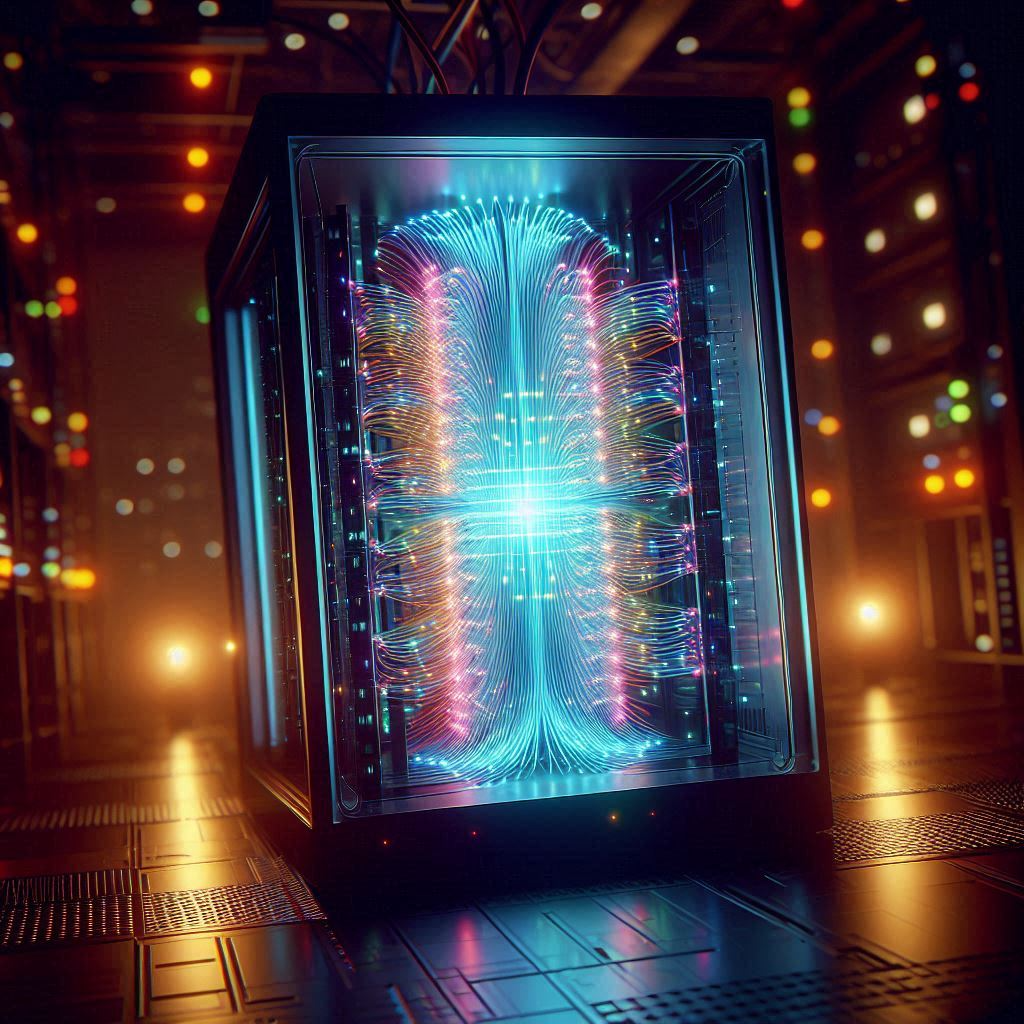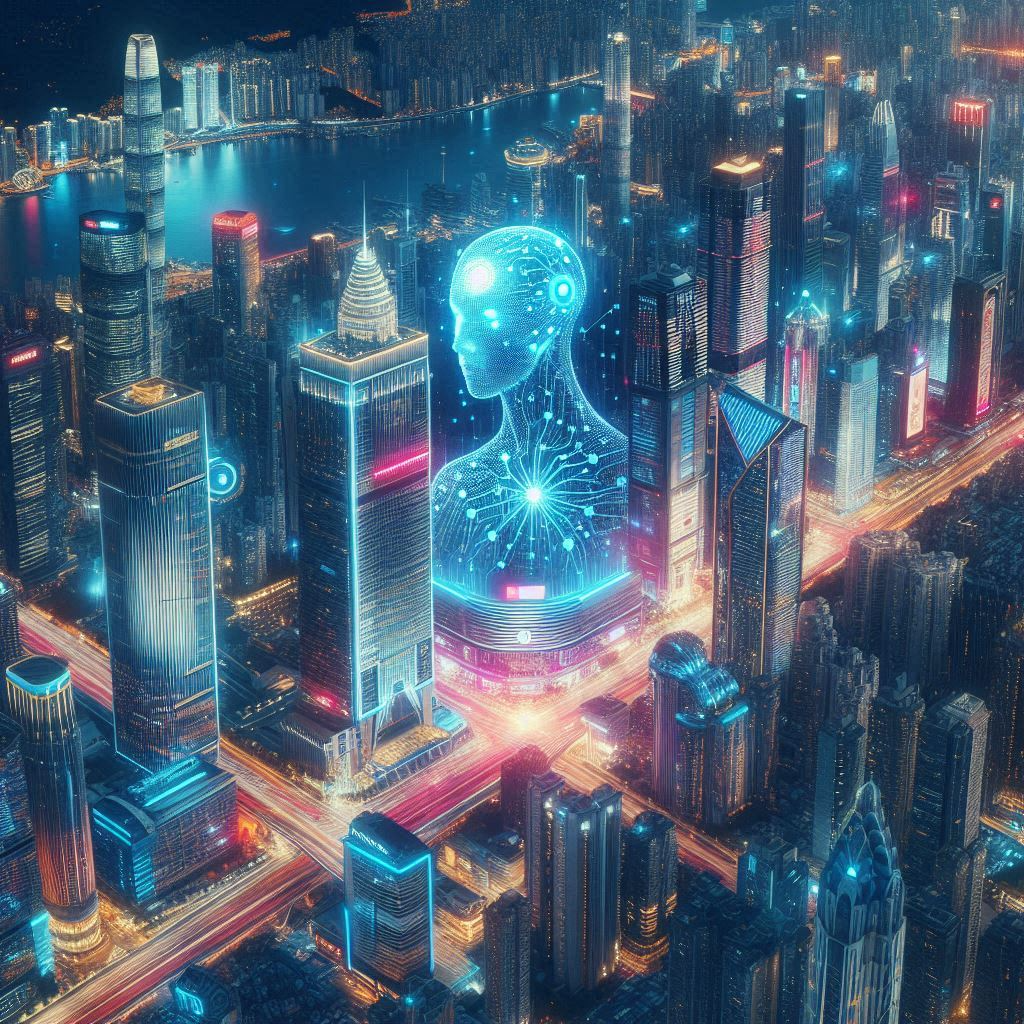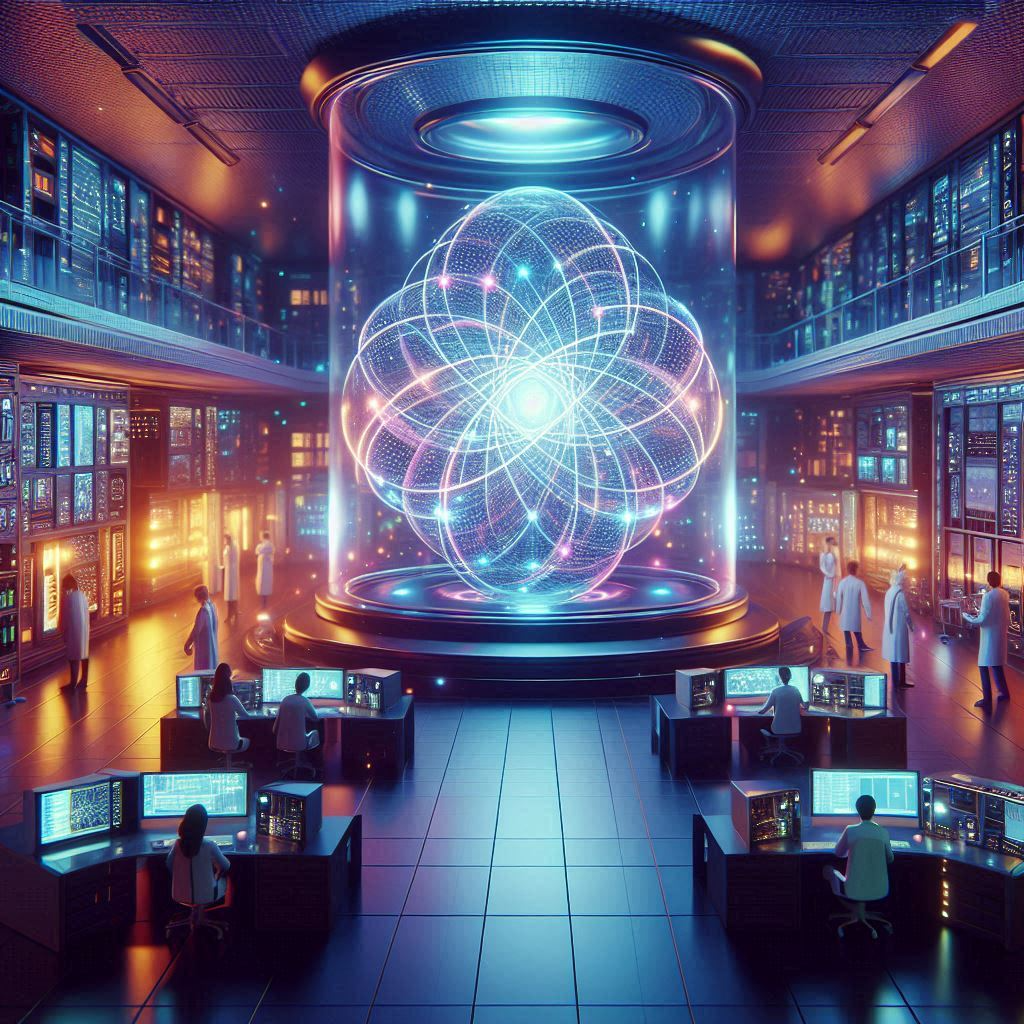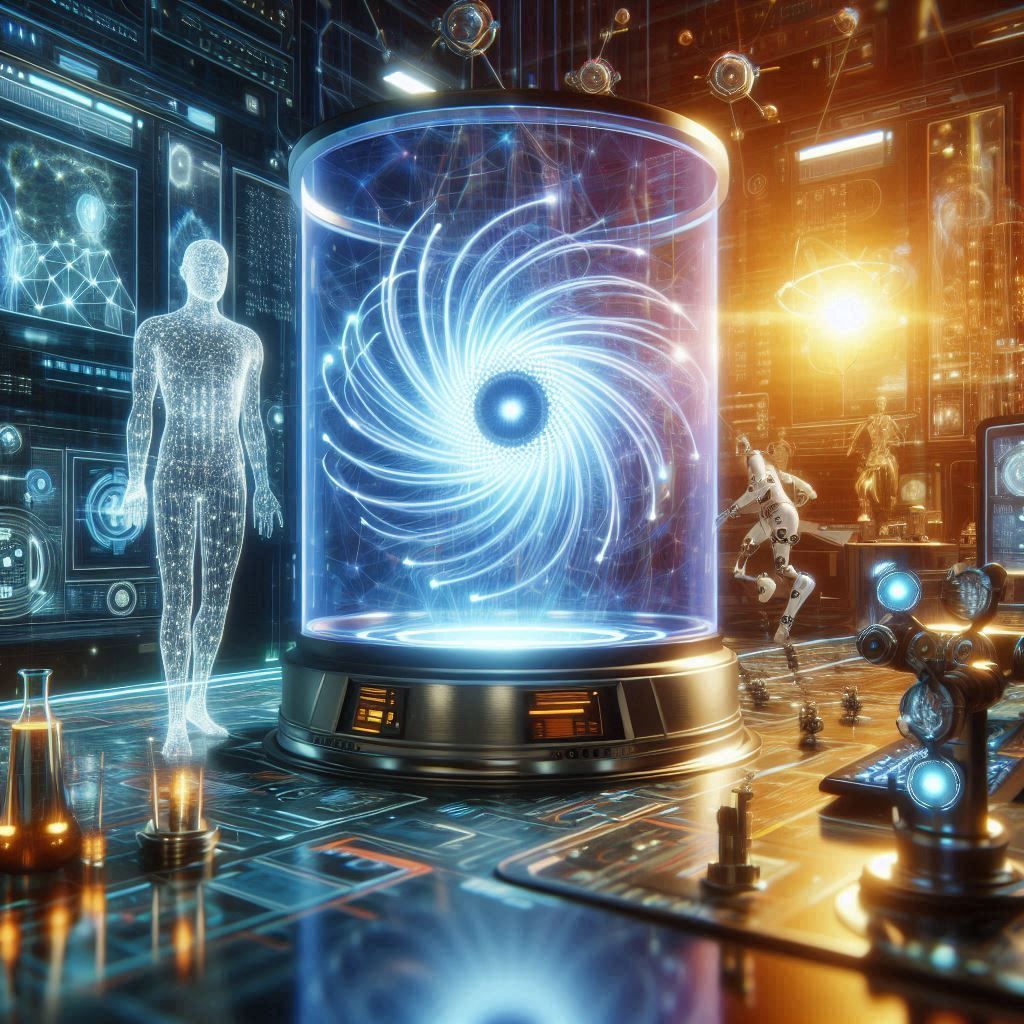and the distribution of digital products.
DM Television
Quantum Computing and AI: A Revolution in Technological Synergy
The convergence of quantum computing and artificial intelligence (AI) represents one of the most promising frontiers in computational science.
\ As quantum computing research scientists, we stand at the precipice of a new era in which the unique capabilities of quantum systems are being harnessed to enhance and accelerate classical AI algorithms, while AI techniques are simultaneously being employed to optimize quantum circuits and mitigate errors in noisy intermediate-scale quantum (NISQ) devices.
\ This synergy is not merely additive but multiplicative, opening up new avenues for solving complex problems that were previously intractable.
\ We provide an in-depth exploration of how quantum computing and classical AI are collaborating synergistically to produce groundbreaking results across various fields.
\
Theoretical Foundations: Quantum Computing Principles
\ Before delving into the synergy between quantum computing and classical AI, it's crucial to revisit the fundamental principles that underpin quantum computation.
\ Quantum computers leverage the principles of quantum mechanics, particularly superposition and entanglement, to perform computations.
\ Superposition allows quantum bits (qubits) to exist in multiple states simultaneously, enabling quantum computers to process vast amounts of information in parallel.
\ Entanglement, often described by Einstein as "spooky action at a distance," allows qubits to be correlated in such a way that the state of one qubit cannot be described independently of the others, even when separated by large distances.
\ These properties give quantum computers a significant advantage over classical computers for certain types of problems, particularly those involving optimization, simulation of quantum systems, and certain mathematical operations like factoring large numbers.
\
Classical AI Fundamentals
\ \ Classical AI, on the other hand, encompasses a broad range of algorithms and techniques designed to enable machines to mimic cognitive functions associated with human intelligence.
\ This includes machine learning (ML), which allows systems to improve their performance on a specific task through experience, and deep learning, which uses artificial neural networks with multiple layers to model and process complex patterns in data.
Key areas of classical AI include:
\ Supervised Learning: Training models on labeled data to make predictions or classifications.
\ Unsupervised Learning: Finding patterns or structures in unlabeled data.
\ Reinforcement Learning: Learning optimal actions through interaction with an environment.
\ Natural Language Processing (NLP): Enabling machines to understand, interpret, and generate human language.
\ Computer Vision: Allowing machines to gain high-level understanding from digital images or videos.
\
The Quantum-Classical AI Synergy
The integration of quantum computing and classical AI is not a simple combination of two distinct technologies, but rather a complex interplay that leverages the strengths of each paradigm to overcome the limitations of the other.
\ This synergy manifests in several key areas:
Quantum-Enhanced Machine LearningQuantum-enhanced machine learning (QML) refers to the use of quantum algorithms to improve the performance or efficiency of classical machine learning tasks. This can be achieved through various approaches:
- Quantum Feature Maps: Mapping classical data into a high-dimensional Hilbert space, potentially allowing for better separation of data points and improved classification.
- Quantum Kernel Estimation: Using quantum circuits to compute kernel functions that are difficult or impossible to compute classically, potentially leading to more powerful support vector machines.
- Quantum Neural Networks: Implementing neural network architectures using quantum circuits, which can potentially represent more complex functions with fewer parameters than their classical counterparts.
\
Quantum-Inspired Classical AlgorithmsThe principles of quantum computation have inspired new classical algorithms that, while not requiring a quantum computer to run, leverage quantum-inspired approaches to solve problems more efficiently:
Tensor Networks: Originally developed to simulate quantum many-body systems, tensor networks have found applications in machine learning, particularly in compressing large neural networks and processing high-dimensional data.
Quantum-Inspired Optimization: Algorithms like the Quantum Approximate Optimization Algorithm (QAOA) have classical analogs that can be used to solve combinatorial optimization problems more efficiently than traditional methods.
\
AI techniques are also being applied to improve various aspects of quantum computing:
Quantum Circuit Optimization: Machine learning algorithms can be used to optimize the design of quantum circuits, reducing gate count and improving fidelity.
Error Mitigation: AI techniques can help in identifying and mitigating errors in noisy quantum systems, a crucial step towards fault-tolerant quantum computation.
Quantum Control: Reinforcement learning algorithms can be used to develop optimal control strategies for manipulating quantum systems.
\
Many current applications combine quantum and classical computing in a hybrid approach, using each where it's most effective:
Variational Quantum Algorithms: Algorithms like the Variational Quantum Eigensolver (VQE) and Quantum Approximate Optimization Algorithm (QAOA) use a quantum processor for state preparation and measurement, while a classical optimizer adjusts the circuit parameters.
Quantum-Classical Neural Networks: These architectures combine quantum layers with classical neural network layers, potentially offering the benefits of both paradigms.
\

We explore the recent breakthroughs that demonstrate the revolutionary potential of combining quantum computing and classical AI, with a focus on the underlying processes and methodologies.
\
- Accelerating Drug Discovery:
\

One of the most promising applications of quantum-enhanced AI is in the field of drug discovery, particularly in the realm of molecular dynamics simulations.
Process:Problem Formulation: The challenge in drug discovery is to simulate the behavior of complex molecules and their interactions with potential drug candidates. This involves solving the Schrödinger equation for many-body systems, which is computationally intractable for classical computers when dealing with large molecules.
\ Quantum Algorithm Development: Researchers have developed quantum algorithms for simulating molecular dynamics, such as the quantum variational eigensolver (VQE) and quantum phase estimation (QPE). These algorithms leverage the natural ability of quantum systems to represent and manipulate quantum states.
\ Hybrid Quantum-Classical Implementation: A hybrid approach is typically used where:
The quantum processor prepares and manipulates quantum states representing molecular configurations. Measurements are performed on these states to extract relevant observables. Classical AI algorithms, typically machine learning models, process this quantum data to identify patterns and make predictions about molecular properties and interactions.
\ Iterative Optimization: The process involves multiple iterations, with the classical AI component guiding the selection of new molecular configurations to be simulated on the quantum processor, effectively creating a feedback loop that refines the search for promising drug candidates.
\ Data Analysis and Candidate Selection: Advanced classical AI techniques, such as deep learning and reinforcement learning, are employed to analyze the vast amount of data generated by the quantum simulations. These AI models can identify potential drug candidates based on their predicted efficacy and safety profiles.
\ Impact: This quantum-enhanced approach to drug discovery is already showing promising results. For example, researchers at Menten AI have used hybrid quantum-classical algorithms to design new proteins, demonstrating the potential to dramatically accelerate the drug discovery process. The ability to more accurately simulate molecular interactions at scale could potentially reduce the time and cost of bringing new drugs to market by years and billions of dollars.
\
- Optimizing Financial Models:
\
Quantum-Enhanced Monte Carlo Methods\

The finance industry is leveraging the quantum-AI synergy to enhance complex financial modeling, particularly in the realm of Monte Carlo simulations for risk assessment and portfolio optimization.
\
Process:Problem Formulation: Many financial models, such as those used for option pricing or risk assessment, rely on Monte Carlo simulations that involve generating and analyzing a large number of random scenarios.
\ Quantum Algorithm Development: Quantum algorithms for Monte Carlo simulation, such as quantum amplitude estimation, have been developed. These algorithms can provide a quadratic speedup over classical Monte Carlo methods in terms of the number of samples required to achieve a given precision.
\ Hybrid Implementation: The quantum processor is used to perform the core sampling process, leveraging quantum superposition to explore multiple scenarios simultaneously. The results of the quantum sampling are then fed into classical AI models, typically machine learning algorithms, for analysis and interpretation.
\ AI-Driven Optimization: Machine learning models, such as neural networks or support vector machines, are trained on the quantum-generated data to identify patterns and make predictions. These models can adapt and improve their performance over time as more data becomes available.
\ Real-Time Analysis: The combination of quantum-accelerated sampling and AI-driven analysis allows for near-real-time updates to financial models, enabling more responsive trading strategies and risk management.
\ Impact: This quantum-enhanced approach to financial modeling is enabling more accurate risk assessment, better portfolio optimization, and more responsive trading strategies. For instance, Goldman Sachs and QC Ware have demonstrated quantum algorithms that could significantly speed up Monte Carlo simulations for derivative pricing, potentially leading to more efficient and stable financial markets.
\
Enhancing Cybersecurity:
\
\

The combination of quantum computing and AI is revolutionizing the field of cybersecurity, both in the development of quantum-resistant cryptographic methods and in enhancing threat detection capabilities.
\
Process:Quantum-Resistant Cryptography Development: Researchers are developing new cryptographic algorithms that are resistant to attacks by both quantum and classical computers, such as lattice-based and hash-based cryptography. Quantum key distribution (QKD) systems are being developed to enable secure communication that is theoretically immune to eavesdropping.
\ AI-Enhanced Cryptanalysis: Machine learning models are being trained on vast datasets of encrypted traffic to identify patterns and anomalies that could indicate potential vulnerabilities or attacks. These AI models can adapt to new types of attacks and encryption methods, providing a dynamic defense against evolving threats.
\ Quantum-Enhanced Network Monitoring: Quantum sensors can be used to detect ultra-weak signals that might indicate a security breach or data exfiltration attempt. The data from these quantum sensors is processed by AI algorithms to identify and classify potential threats in real-time.
\ Hybrid Quantum-Classical Threat Simulation: Quantum computers are used to simulate complex attack scenarios that would be infeasible to model classically. AI algorithms analyze these simulations to develop and refine defense strategies.
\ Continuous Learning and Adaptation: The AI components of the system continuously learn from new data and simulations, updating their models to stay ahead of emerging threats. This adaptive approach allows the security system to evolve and improve over time rather than relying on static defenses.
\ Impact: This quantum-AI approach to cybersecurity is creating a new paradigm that is proactive rather than reactive. For example, researchers at Los Alamos National Laboratory have demonstrated a quantum-based cybersecurity system that can detect and deflect quantum-level attacks, potentially preventing cyber attacks before they can cause damage. This technology could be crucial in protecting critical infrastructure and sensitive data in the quantum era.
\
- Revolutionizing Climate Modeling:
\
Quantum-Enhanced Earth System Simulations\

Climate change is one of the most pressing issues of our time, and accurate climate modeling is crucial for developing effective mitigation strategies. The combination of quantum computing and AI is dramatically improving our ability to model and predict climate patterns.
\
Process:Problem Formulation: Earth system models involve complex, non-linear interactions between the atmosphere, oceans, land surface, and ice. Traditional modeling approaches struggle to capture these interactions at high resolutions due to computational limitations.
\ Quantum Algorithm Development: Researchers have developed quantum algorithms for fluid dynamics simulations and solving partial differential equations, which are crucial components of climate models.
\ Hybrid Quantum-Classical Implementation: Quantum processors are used to simulate the most computationally intensive aspects of the climate system, such as atmospheric and oceanic dynamics. These quantum simulations are integrated with classical components of the Earth system model. AI algorithms, particularly deep learning models, are used to analyze the outputs of the quantum-classical simulations and identify patterns and trends.
\ Multi-Scale Modeling: The quantum-AI approach allows for seamless integration of simulations at different scales, from global climate patterns down to regional and local effects.
\ Data Assimilation and Prediction: Machine learning techniques are used to assimilate observational data into the model, continuously improving its accuracy. AI-driven predictive models use the outputs of the quantum-enhanced simulations to make short-term and long-term climate predictions.
\ Uncertainty Quantification: Quantum algorithms for uncertainty quantification are combined with classical statistical methods to provide more robust estimates of the uncertainty in climate predictions.
\ Impact: This enhanced modeling capability is providing policymakers and scientists with more accurate and detailed information about climate change. For instance, researchers at the University of Chicago and Argonne National Laboratory have demonstrated quantum algorithms for solving partial differential equations that could significantly accelerate climate simulations. This could lead to more effective strategies for climate change mitigation and adaptation, potentially altering the course of global environmental policy.
\ \
Transforming Materials Science:
\
\

The development of new materials has traditionally been a time-consuming and often serendipitous process.
\ However, the combination of quantum computing and AI is ushering in a new era of rational materials design.
\
Process:Quantum Simulation of Materials: Quantum computers are used to simulate the behavior of materials at the atomic and subatomic levels, considering quantum effects that are crucial to material properties but difficult to model classically.
\ AI-Driven Analysis and Prediction: Machine learning models, particularly deep neural networks, are trained on the results of quantum simulations to predict the properties of potential new materials. These AI models can rapidly screen vast numbers of possible material compositions and structures, identifying promising candidates for further study.
\ Inverse Design: AI algorithms are used to solve the inverse problem of materials design, starting with desired properties and working backwards to identify potential structures that could exhibit these properties.
\ Quantum-Classical Feedback Loop: The AI predictions guide the selection of new materials to be simulated on the quantum computer. The results of these simulations are then fed back into the AI models, continuously improving their accuracy and predictive power.
\ Experimental Validation and Refinement: The most promising candidates identified by the quantum-AI system are synthesized and tested experimentally. The results of these experiments are used to further refine the quantum simulations and AI models, creating a virtuous cycle of improvement.
\ Multi-objective Optimization: Advanced AI techniques, such as reinforcement learning and multi-objective evolutionary algorithms, are used to optimize materials for multiple, often competing, properties simultaneously.
\ Impact: This approach is accelerating the discovery of new materials with specific desired properties. For example, researchers at the University of Toronto and Google have used a combination of quantum computing and machine learning to discover new magnetic materials for use in quantum devices. This quantum-AI-driven approach to materials science could transform industries from energy to aerospace, enabling the development of more efficient solar cells, stronger and lighter structural materials, and novel quantum devices.
\
Challenges and Future Prospects for Quantum AIWhile the combination of quantum computing and classical AI is yielding impressive results, several challenges remain:
\ Quantum Hardware Limitations: Current quantum computers are still limited in their number of qubits and coherence times, restricting the scale of problems that can be addressed.
\ Error Mitigation: Quantum systems are highly susceptible to noise and errors, necessitating the development of more robust error correction techniques.
\ Algorithm Development: Creating efficient quantum algorithms that outperform classical counterparts for practical problems remains a significant challenge.
\ Integration Challenges: Seamlessly integrating quantum and classical systems poses technical difficulties, particularly in terms of data transfer and synchronization.
\ Scalability: As quantum systems grow in size and complexity, managing and controlling them becomes increasingly challenging.
\ \ Despite these challenges, the future prospects for quantum-enhanced AI are extremely promising.
\ As quantum hardware continues to improve and new algorithms are developed, we can expect to see even more groundbreaking applications.
\
Future Ground-Breaking Applications
Some areas of particular interest for future research include:
\ Quantum Machine Learning: Developing new quantum algorithms for machine learning tasks that can demonstrate clear quantum advantage over classical methods.
\ Quantum-Inspired Classical Algorithms: Further exploration of how quantum concepts can inspire new classical algorithms, potentially bridging the gap between quantum and classical computation.
\ Quantum Neural Networks: Advancing the theory and implementation of quantum neural networks, potentially leading to more powerful and efficient AI models.
\ Quantum Reinforcement Learning: Exploring how quantum computing can enhance reinforcement learning algorithms, particularly for complex, high-dimensional problems.
\ Quantum-Enhanced Federated Learning: Investigating how quantum computing can address privacy and security concerns in distributed machine learning systems.
\
Conclusion\ The convergence of quantum computing and classical AI represents one of the most exciting frontiers in computational science today.
\ By combining the unique strengths of both paradigms – the ability of quantum computers to efficiently solve certain classes of problems and the pattern recognition and learning capabilities of AI – we are opening up new possibilities that were once thought to be beyond reach.
\ As quantum computing research scientists are at the forefront of this revolution, tasked with developing the algorithms, hardware, and theoretical frameworks that will shape the future of computation.
\ The breakthroughs we've discussed – from accelerating drug discovery to revolutionizing climate modeling – are just the beginning of what promises to be a transformative era in computational science.
\ The synergy between quantum computing and classical AI is not just changing technology; it's changing our very understanding of what's possible.
\ We are moving towards a future where some of humanity's most pressing challenges – from disease to climate change to resource management – can be addressed with unprecedented speed and precision.
\ However, realizing this potential will require continued collaboration across disciplines.
\ Quantum physicists, computer scientists, mathematicians, and domain experts in various fields must work together to develop practical applications that can harness the power of quantum-enhanced AI.
\ Moreover, we must remain mindful of the ethical implications of these powerful technologies, ensuring that they are developed and deployed responsibly.
\ As we look to the future, it's clear that the quantum AI revolution is just beginning.
\
Exciting Possible Future Developments\

Fault-Tolerant Quantum Computing: The achievement of large-scale, fault-tolerant quantum computers could dramatically expand the range of problems that can be tackled with quantum-enhanced AI.
\ Quantum Internet: The development of a quantum internet could enable distributed quantum-AI systems, opening up new possibilities for secure, long-distance quantum computation and communication.
\ Neuromorphic Quantum Computing: The integration of quantum computing with neuromorphic hardware could lead to novel AI architectures that more closely mimic the human brain.
\ Quantum Machine Learning for Quantum Data: As quantum sensors and quantum communication networks become more prevalent, we may see the development of quantum machine learning algorithms specifically designed to process and analyze quantum data.
\ Quantum-Enhanced Natural Language Processing: Quantum algorithms for natural language processing could potentially lead to more sophisticated language models and translation systems.
\
EpilogueThe integration of quantum computing and classical AI represents a new frontier in computational science, one that promises to redefine the limits of what we can compute, predict, and understand about the world around us.
\ Quantum computing research scientists have the privilege and responsibility of shaping this future.
\ By continuing to push the boundaries of what's possible, they can help unlock solutions to some of the world's most pressing problems and open up new avenues of scientific inquiry.
\ The journey ahead is challenging but immensely exciting.
\ It calls for creativity, rigorous scientific inquiry, and a willingness to challenge our existing paradigms.
\ As we continue to explore the synergies between quantum computing and classical AI, we are not just advancing technology – we are expanding the frontiers of human knowledge and capability.
\

- Forbes: If You Think AI Is Hot, Wait Until It Meets Quantum Computing
- NVIDIA: Hybrid Quantum-Classical Computing Platform
- IBM: Quantum Computer Demonstrates Next Step Towards Moving Beyond Classical Supercomputing
- DARPA: Quantum Computing Breakthrough
- IBM: Next-Generation Quantum Processor & IBM Quantum System Two
- IEEE Quantum Week: QCE23 Workshops Program
- ScienceDirect: Quantum Computing in Clinical Trial Design and Analysis
- TechXplore: Hybrid Quantum-Classical Algorithm Accelerates Dynamic Mode Decomposition
- The Science Brigade: Hybrid Quantum-Classical Machine Learning Models
- Capitol Technology University: Supercharging AI with Quantum Computing
\
:::info All images generated by Enhance-Prompted Microsoft Designer, which uses a refined version of DALL-E 3. It’s fun!
:::
\ While I do not monetize my writing directly, your support helps me continue publishing articles like this one without a paywall or a paid subscription. If you want to support my writing, consider a contribution at Patreon on this link:
https://www.patreon.com/c/thomascherickal/membership
Alternatively, you could buy me a coffee on this link:
https://ko-fi.com/thomascherickal
\
- Home
- About Us
- Write For Us / Submit Content
- Advertising And Affiliates
- Feeds And Syndication
- Contact Us
- Login
- Privacy
All Rights Reserved. Copyright , Central Coast Communications, Inc.